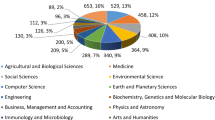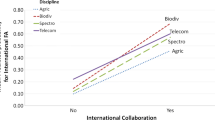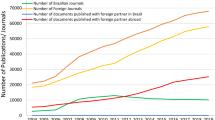Abstract
Based on publications indexed in the Web of Science, the current study focused on internationally collaborated publications and publications acknowledging government funding of developing and developed countries including China, the US, Germany, the Netherlands, South Africa, and Brazil. Specific focus is placed on national funding agencies (i.e., focal agencies) supporting competitive research in science. The focal agencies of the six countries include the National Natural Science Foundation of China (NSFC), the US National Science Foundation (NSF), German Research Foundation, the Netherlands Organization for Scientific Research (NWO), National Research Foundation of South Africa (NRF), and National Council for Scientific and Technological Development of Brazil (CNPq). Results show that different countries vary in arrangement of government funding sources in support of competitive research projects. China and Brazil are centralized to the NSFC and CNPq, whereas the remaining four countries have relatively decentralized sources. The six focal national funding agencies of the current study are more efficient than non-focal agencies in raising citation impact, with the NWO, NSF, and NSFC perform better than non-focal agencies of corresponding countries. International collaboration improves citation impact, with the developing countries benefit more. Authorship (first or corresponding authorship) also plays a role in international collaboration. Collaboration led by authors from developed countries has a positive effect whereas that led by authors from developing countries usually have negative effects on citation impact. Interaction between funding and collaboration may have results different from those when these two factors are considered separately, which suggests being cautious while discussing effects of either of the two factors.





Similar content being viewed by others
Notes
Agriculture and Food Science, Astronomy and Astrophysics, Basic Life Sciences, Basic Medical Sciences, Biological Sciences, Biomedical sciences, Chemistry and Chemical Engineering, Civil Engineering and Construction, Clinical Medicine, Computer Sciences, Earth Sciences and Technology, Electrical Engineering and Telecommunication, Energy Science and Technology, Environmental Sciences and Technology, General and Industrial Engineering, Health Sciences, Instruments and Instrumentation, Mathematics, Mechanical Engineering and Aerospace, Multidisciplinary Journals, Physics and Materials Science, Statistical Sciences.
References
Adams, J. (2012). Collaborations: The rise of research networks. Nature. https://doi.org/10.1038/490335a.
Bozeman, B., & Corley, E. (2004). Scientists’ collaboration strategies: Implications for scientific and technical human capital. Research Policy, 33(4), 599–616. https://doi.org/10.1016/j.respol.2004.01.008.
Bozeman, B., Fay, D., & Slade, C. P. (2013). Research collaboration in universities and academic entrepreneurship: The-state-of-the-art. Journal of Technology Transfer. https://doi.org/10.1007/s10961-012-9281-8.
Chen, K., Zhang, Y., & Fu, X. (2019). International research collaboration: An emerging domain of innovation studies? Research Policy, 48(1), 149–168. https://doi.org/10.1016/j.respol.2018.08.005.
Choi, S., Yang, J. S. W., & Park, H. W. (2015). The triple helix and international collaboration in science. Journal of the Association for Information Science and Technology. https://doi.org/10.1002/asi.23165.
Cimini, G., Zaccaria, A., & Gabrielli, A. (2016). Investigating the interplay between fundamentals of national research systems: Performance, investments and international collaborations. Journal of Informetrics, 10(1), 200–211. https://doi.org/10.1016/j.joi.2016.01.002.
Clark, B. Y., & Llorens, J. J. (2012). Investments in scientific research: Examining the funding threshold effects on scientific collaboration and variation by academic discipline. Policy Studies Journal, 40(4), 698–729. https://doi.org/10.1111/j.1541-0072.2012.00470.x.
Corredoira, R. A., Goldfarb, B. D., & Shi, Y. (2018). Federal funding and the rate and direction of inventive activity. Research Policy. https://doi.org/10.1016/j.respol.2018.06.009.
D’Ippolito, B., & Rüling, C. C. (2019). Research collaboration in large scale research infrastructures: Collaboration types and policy implications. Research Policy, 48(5), 1282–1296. https://doi.org/10.1016/j.respol.2019.01.011.
De Moya-Anegon, F., Guerrero-Bote, V. P., Lopez-Illescas, C., & Moed, H. F. (2018). Statistical relationships between corresponding authorship, international co-authorship and citation impact of national research systems. Journal of Informetrics, 12(4), 1251–1262. https://doi.org/10.1016/j.joi.2018.10.004.
Frame, D., & Carpenter, M. P. (1979). International research collaboration. Social Studies of Science, 9(4), 481–497.
Guan, J., Yan, Y., & Zhang, J. J. (2017). The impact of collaboration and knowledge networks on citations. Journal of Informetrics, 11(2), 407–422. https://doi.org/10.1016/j.joi.2017.02.007.
Guerrero Bote, V. P., Olmeda-Gómez, C., & de Moya-Anegón, F. (2013). Quantifying the Benefits of International Scientific Collaboration. Journal of the American Society for Information Science, 64(2), 392–404. https://doi.org/10.1002/asi.22754.
Lancho-Barrantes, B. S., Guerrero-Bote, V. P., & de Moya-Anegón, F. (2013). Citation increments between collaborating countries. Scientometrics, 94(3), 817–831. https://doi.org/10.1007/s11192-012-0797-3.
Lee, S., & Bozeman, B. (2005). The impact of research collaboration on scientific productivity. Social Studies of Science. https://doi.org/10.1177/0306312705052359.
Leydesdorff, L., Bornmann, L., & Wagner, C. S. (2019a). The relative influences of government funding and international collaboration on citation impact. Journal of the Association for Information Science and Technology, 70(2), 198–201.
Leydesdorff, L., & Wagner, C. S. (2008). International collaboration in science and the formation of a core group. Journal of Informetrics. https://doi.org/10.1016/j.joi.2008.07.003.
Leydesdorff, L., Wagner, C. S., & Bornmann, L. (2019b). Interdisciplinarity as diversity in citation patterns among journals: Rao-Stirling diversity, relative variety, and the Gini coefficient. Journal of Informetrics. https://doi.org/10.1016/j.joi.2018.12.006.
Liu, A. M. M., Liang, O. X., Tuuli, M., & Chan, I. (2018). Role of government funding in fostering collaboration between knowledge-based organizations: Evidence from the solar PV industry in China. Energy Exploration & Exploitation, 36(3), 509–534. https://doi.org/10.1177/0144598717742968.
Moya-Anegón, F., Guerrero-Bote, V. P., Bornmann, L., & Moed, H. F. (2013). The research guarantors of scientific papers and the output counting: A promising new approach. Scientometrics, 97(2), 421–434. https://doi.org/10.1007/s11192-013-1046-0.
Sandström, U., & Den Van Besselaar, P. (2016). Quantity and/or quality? The importance of publishing many papers. PLoS ONE, 11(11), 0166149. https://doi.org/10.1371/journal.pone.0166149.
Sandström, U., & Van den Besselaar, P. (2018). Funding, evaluation, and the performance of national research systems. Journal of Informetrics, 12(1), 365–384. https://doi.org/10.1016/j.joi.2018.01.007.
Sud, P., & Thelwall, M. (2016). Not all international collaboration is beneficial: The Mendeley readership and citation impact of biochemical research collaboration. Journal of the Association for Information Science and Technology, 67(8), 1849–1857. https://doi.org/10.1002/asi.23515.
Todeva, E., & Knoke, D. (2005). Strategic alliances and models of collaboration. Management Decision. https://doi.org/10.1108/00251740510572533.
Ubfal, D., & Maffioli, A. (2011). The impact of funding on research collaboration: Evidence from a developing country. Research Policy, 40(9), 1269–1279. https://doi.org/10.1016/j.respol.2011.05.023.
Van Raan, A. F. J. (1998). The influence of international collaboration on the impact of research results—Some simple mathematical considerations concerning the role of self-citations. Scientometrics, 42(3), 423–428. https://doi.org/10.1007/BF02458380.
Wagner, C. S. (2018). The collaborative era in science. London: Palgrave Macmillan.
Wagner, C. S., Park, H. W., & Leydesdorff, L. (2015). The continuing growth of global cooperation networks in research: A conundrum for national governments. PLoS ONE, 10(7), 1–15. https://doi.org/10.1371/journal.pone.0131816.
Wang, L., Wang, X., & Philipsen, N. J. (2017). Network structure of scientific collaborations between China and the EU member states. Scientometrics, 113(2), 765–781. https://doi.org/10.1007/s11192-017-2488-6.
Yan, E., Wu, C., & Song, M. (2018). The funding factor: A cross-disciplinary examination of the association between research funding and citation impact. Scientometrics, 115(1), 369–384. https://doi.org/10.1007/s11192-017-2583-8.
Zhao, Q., & Guan, J. (2011). International collaboration of three ‘giants’ with the G7 countries in emerging nanobiopharmaceuticals. Scientometrics, 87(1), 159–170. https://doi.org/10.1007/s11192-010-0311-8.
Zhou, P., & Bornmann, L. (2014). An overview of academic publishing and collaboration between China and Germany. Scientometrics. https://doi.org/10.1007/s11192-014-1418-0.
Zhou, P., Cai, X., Xiong, W., & Lyu, X. (2019). A bibliometric perspective on the roles of government funding and international collaboration in scientific research. In 17th International Conference on Scientometrics & Informetrics, (pp. 1537–1547). Roma.
Zhou, Ping, & Tian, H. (2014). Funded collaboration research in mathematics in China. Scientometrics, 99(3), 695–715. https://doi.org/10.1007/s11192-013-1212-4.
Zhou, Ping, Zhong, Y., & Yu, M. (2013). A bibliometric investigation on China-UK collaboration in food and agriculture. Scientometrics, 97(2), 267–285. https://doi.org/10.1007/s11192-012-0947-7.
Acknowledgements
This study is supported by National Natural Science Foundation of China (Grant Number: 71843012) and the major basic theoretical research Project of Zhejiang University (Grant Number 16ZDJC003). Thank the Centre for Science and Technology Studies (CWTS) in Leiden University for allowing access to its CWTS-licensed version of the Web of Science database (WoS) of Clarivate. Dr. Rodrigo Costas, a senior researcher of CWTS, provided suggestions of selecting target countries and indicators. Dr. Clara Calero-Medina, a researcher of CWTS offered help in collecting funded data of CWTS. We are grateful for the reviewer’s comments and suggestions.
Author information
Authors and Affiliations
Corresponding author
Rights and permissions
About this article
Cite this article
Zhou, P., Cai, X. & Lyu, X. An in-depth analysis of government funding and international collaboration in scientific research. Scientometrics 125, 1331–1347 (2020). https://doi.org/10.1007/s11192-020-03595-2
Received:
Published:
Issue Date:
DOI: https://doi.org/10.1007/s11192-020-03595-2




